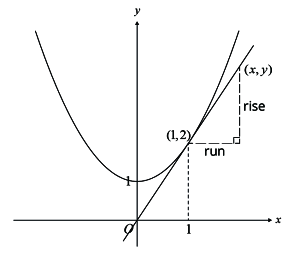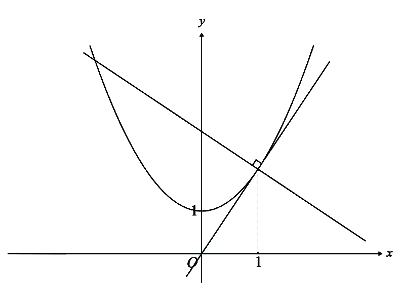Applications Of Differentiation
In this article, we will learn about the various applications of differentiation. The details covered are as per the syllabus laid out for Secondary 4 A Math coursework. We will cover the following subtopics.
- Applications of differentiation rules and differentiation techniques in various areas of mathematics and real life.
- Tangent and Normal Equations.
- The mapping of differentiation to coordinate geometry.
Introduction To The Gradient
Here’s a curve with the equation \(\begin{align*} y=x^2 \end{align*}\)
On differentiating, we get \(\begin{align*} \frac {dy} {dx} = 2x \end{align*}\). This value of \(\begin{align*} \frac {dy} {dx} \end{align*}\) will give you the gradient of the tangent to the curve for every value of \(\begin{align*} x \end{align*}\).
|
 |
Finding Equation Of Tangent To A Function At A Point
Now, let’s see how this gradient table can be used in coordinate geometry.
You might often see questions like finding the equation of the tangent to a function at a point.
In such cases, they’ll give you a point marked on the curve and ask you to find the tangent at that point.

So, let’s consider, \(\begin{align*} y=x^2+1 \end{align*}\)
On applying the differentiation rule, we get \(\begin{align*} \frac {dy} {dx} = 2x \end{align*}\)
We have to substitute the value of \(\begin{align*} x \end{align*}\) here.
At \(\begin{align*} x=1 \end{align*}\),
\(\begin{align*} \implies\quad\; y &= 1^2 + 1 \\[2ex] \implies\qquad &= 2 \end{align*}\)
Hence,
\(\begin{align*} \implies\quad\; \frac {dy} {dx} &= 2 \times 1 \\[2ex] \implies\qquad\quad &=2 \end{align*}\)
Finding Equation Of Tangent
- Given that \(\displaystyle{\frac {dy}{dx}}\) is the gradient and the coordinates of one of the points lie on the line, you need to use the standard formula for a straight line,
i.e. \(\displaystyle{ y = mx +C }\).
- First, we need to substitute \(m= 2\), which is the gradient,
i.e. \(\begin{align*} y=2x+C \end{align*}\).
- Then, we will substitute the values of fixed points of \(\begin{align*} y \end{align*}\) and \(\begin{align*} x \end{align*}\). So,
\(\begin{align*}\\ \implies 2 &= 2 × 1 + c \\[2ex] \implies c &= 0 \end{align*}\)
Therefore, the equation is
\(\displaystyle{ y = 2x }\).
Alternative Method To Find The Tangent Equation
Another way to find the equation of the straight line is as follows.
- A gradient is also known as the ratio between rise and run. Also, we know here the contact point given is \(\begin{align*} (1, 2) \end{align*}\).
- Taking another point as \(\begin{align*} (x, y) \end{align*}\).
- Now, \(\begin{align*} \frac { dy} { dx} = \frac { y-2} { x-1} \end{align*}\). So, we have the gradient of a straight line that can be calculated as vertical change divided by horizontal change.
Hence, the equation of tangent is
\(\begin{align} \implies\quad\; y-2 &= \frac{dy}{dx}(x-1) \\[2ex] \implies\quad\; y-2 &= 2x-2 \\[2ex] \implies\quad\qquad y &= 2x \end{align}\)
The equation of the tangent to a function at a point \(\begin{align*} (x_1, y_1) \end{align*}\) is given by \(\begin{align*} y - y_1 = m(x - x_1) \end{align*}\), where \(\begin{align*} m \end{align*}\) is the value of \(\displaystyle{\frac {dy}{dx}}\) at \(x = x_1\).
Therefore, the thing you need to substitute in \(y_1\) and \(x_1\) is the point at which the question asks you to find the tangent. Thereafter, substitute \(\displaystyle{\frac {dy}{dx}}\) into \(m\) and perform the algebraic manipulations required to complete the working.
Question 1:
Find the equation of the tangent to the curve \(\begin{align*} y = 2x^3- 2x + 1 \end{align*}\) at the point where \(x = - 1\).
Solution:
- It is given that \(\begin{align*} y = 2x^3- 2x + 1 \end{align*}\)
Now, after differentiating, we have \(\begin{align*} \frac { dy} { dx} = 6x^2-2 \end{align*}\).
- When \(x = -1,\)
\(\begin{align*} y &= 2(-1)^3 - 2(-1) + 1 \\ \\ &= 1 \\ \\ \end{align*}\)
Therefore,
\(\begin{align*} \frac {dy}{dx} &= 6(-1)^2 - 2 \\ \\ &= 4 \\ \end{align*}\)
Therefore, the tangent passes through the point \((-1,1)\) and has a gradient of \(4\).
- Now, the equation of the tangent is \(\begin{align*} y - y_1 = m(x - x_1) \end{align*}\)
\(\begin{align*} \implies\; y - 1 &= 4 (x - (-1)) \\[2ex] \implies \qquad y &= 4x + 4+ 1 \\[2ex] \implies \qquad y &= 4x + 5 \end{align*}\)
So, the equation of tangent is \(\begin{align*} y = 4x + 5 \end{align*}\).
Application Of Perpendicular Lines Concept
So now, you already know the concept of perpendicular lines in coordinate geometry.
Given below are two lines that are perpendicular to each other.
The gradient of line \(\begin{align*} 1 = m_1 \end{align*}\)
The gradient of line \(\begin{align*} 2 = m_2 \end{align*}\)
So, the relationship between these two numbers:
\(\begin{align*} \implies\qquad m_1 × m_2 &= -1 \\[2ex] \implies\qquad\qquad\>\> m_2 &= -\frac { 1} { m_2} \end{align*}\)
It means that one of the gradient equals the negative reciprocal of the other.
Finding Equation Of Normal To A Function At A Point
For every point, we have a tangent to the curve. And the perpendicular line from the same point is called the normal. But we have to find the gradient to get the equation of the normal to the given point.

So, at \(x = 1, \;y = 2 \)
\(\displaystyle{ \implies\qquad \frac { dy} { dx} =2 }\)
Gradient of the normal \(\begin{align*}\\[5ex] &= \frac{ -1}{ \big({}^{dx}/_{dy} \big) }\\[2ex] &= -\frac{1}{2} \end{align*}\)
Equation of the normal:
\(\begin{align*} \implies\qquad\> y - 2 &= -\frac{1}{2}(x - 1) \\[2ex] \implies\qquad\qquad y &= -\frac{1}{2}x + \frac{1}{2} + 2 \\[2ex] \implies\qquad\qquad y &= -\frac { 1} {2 }x \;+ \;2\frac { 1} {2} \end{align*}\)
Question 2:
Find the equation of the normal to the curve \(\begin{align*} y = 2x^3 - 2x + 1 \end{align*}\) at the point where \(x = -1.\)
Solution:
- As per the question, \(\begin{align*} y = 2x^3 - 2x + 1 \end{align*}\)
On differentiating, we get
\(\begin{align*} \implies\qquad \frac { dy} { dx} = 6x^2 - 2 \end{align*}\).
- When \(x = -1,\)
\(\begin{align*} \implies\qquad\; y &= -2 + 2 + 1 \\[2ex] \implies\qquad\quad &= 1 \end{align*}\)
Then,
\(\begin{align*} \implies\qquad\; \frac { dy} { dx} &= 6 - 2 \\[2ex] \implies\qquad\qquad &= 4 \end{align*}\)
- Gradient of the normal \(= \displaystyle{- \frac { 1} { 4}}\)
Therefore, the normal passes through \((-1, 1)\) with gradient \(\displaystyle{- \frac { 1} { 4}}\).
- Equation of the normal:
\(\begin{align*} \implies\qquad\> y - 1 &= -\frac{1}{4} \big[x - (-1)\big] \\[2ex] \implies\qquad\> y - 1 &= -\frac{1}{4}x - \frac{1}{ 4} \\[2ex] \implies\qquad\qquad y &= -\frac{1}{ 4}x + \frac{3} {4} \end{align*}\)
Finding The Point Where The Tangent or Normal Cuts The Curve Again
When you find the equation of the tangent or normal, the first thing you can do is to find where the line in the curve intersects again. So, let’s see.

- It is given that
\(\begin{align} y &= x^2 + 1 & ----- (1) \end{align}\)
The normal is
\(\begin{align} y &= -\frac {1} {2}x + 2\frac {1} {2} & ----- (2) \end{align}\)
We have to equate the above two equations to each other.
- So, letting \((1) = (2)\)
\(\begin{align} x^2 + 1 = -\frac{1}{2}x + 2\frac{1}{2} \end{align}\)
- Now, we solve for \(x\),
\(\begin{align} \implies\qquad\>\>\;x^2 + \frac{1}{2}x - 1\frac{1} {2} &=0 \\[2ex] \implies\qquad\qquad 2x^2+x-3 &=0 \\[2ex] \implies\qquad\>\> (2x+3)(x-1)&=0 \\[2ex] \implies\qquad x= -\frac {3}{2} \quad\text {or}\quad x&=1 \end{align}\)
- We substitute \(\displaystyle{x= -\frac {3}{2}}\) into \((1)\)
- We get,
\(\begin{align} \implies\qquad\> y &= \bigg(-\frac {3}{2}\bigg)^2 +1 \\[2ex] \implies\qquad\quad &= \frac {9}{4} +1 \\[2ex] \implies\qquad\quad &= 3\frac {1}{4} \end{align}\)
Therefore, the point is \(\displaystyle{( -1\frac {1}{2}\; , \;3\frac {1}{4} )}\).
Question 3:
A point \(P\;(-1 , 1)\) lies on the curve \(y = 2x^3 - 2x +1\).
- Find the equation of the tangent to the curve at this point.
- Find the coordinates of the point at which this tangent cuts the curve again.
Solution:
- Given in the question, the equation of the curve is \(y = 2x^3 - 2x +1\)
After doing differentiation, we get
\(\begin{align*} \implies\qquad \frac { dy} { dx} &= 6x^2 - 2 \end{align*}\)
We already have the value \(P(-1, 1)\).
So, when \(x = -1\),
\(\begin{align*} \implies\qquad\> \frac{dy}{dx} &= 6 - 2 \\[2ex] \implies\qquad\qquad &= 4 \end{align*}\)
Equation of tangent:
\(\begin{align*} \implies\qquad\> y - 1 &= 4\big[x - (-1)\big] \\ \\ \implies\qquad\qquad y &= 4x+5 \end{align*}\)
- We want to have a simultaneous equation between the straight line and function.
\(\begin{align} y &= 4x + 5 & ----- (1)\\[2ex] y &= 2x^3 - 2x +1 & -----(2) \end{align}\)
Substituting \((1)\) into\( (2)\)
\(\begin{align*} \implies\qquad\quad\;\,\: 4x + 5 &= 2x^3 - 2x +1 \\[2ex] \implies\quad 2x^3- 6x - 4 &= 0 \\[2ex] \implies \quad\;\; x^3- 3x -2 &= 0 \end{align*}\)
To solve the cubic equation, you must first find one factor and then compare the coefficients to get the positive equation on the other side. Then, you have to solve the positive equation. Note that one of the factors is \((x + 1)\).
Thus,
\(\begin{align*} (x + 1) (ax^2 + bx + c) = 0 \end{align*}\)
By comparing the coefficients, we have \(a = 1; \;\;c = -2;\)
Coefficient of \(x\) in above equation is \((bx \times 1) + (cx) = (b + c)x\)
So,
\(\begin{align*} \implies\qquad\,\, b + c &= -3, \\ \\ \implies\qquad\; b - 2 &= -3, \\ \\ \implies\qquad\qquad b &= -1 \end{align*}\)
Now,
\(\begin{align*} \implies\qquad\quad\, (x + 1) (x^2 - x - 2) &= 0 \\[2ex] \implies\qquad\:\, (x + 1) (x + 1) (x - 2) &= 0 \\[2ex] \implies\qquad\qquad\quad x = -1 \quad \text {or} \quad x &= 2 \end{align*}\)
Now, substitute \( x = 2\) into either of the equations, but ensure to choose the other point that has not intersected the curve yet.
So, substituting \( x = 2\) into \((1)\)
\(\begin{align*} \implies\qquad\; y &= 4(2) + 5 \\[2ex] \implies\qquad\quad &= 13 \end{align*}\)
Coordinates of the other point \(= (2, 13)\).
Conclusion
In this article, we learned about the applications of differentiation in the form of tangent and normal. We also covered on the explanation of the equation of the tangent, normal, and point where they both cut the curve again.
| Continue Learning | |
|---|---|
| Introduction To Differentiation | Applications Of Differentiation |
| Differentiation Of Exponential And Logarithmic Functions | Integration Techniques |
| Applications Of Integration | |


 SG
SG  VN
VN 















